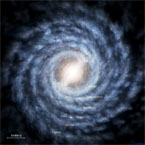Milky Way may be a ‘galactic cannibal’
 Canberra, April 8: Astronomers have identified a huge swathe of debris that has been wrenched from a neighbouring galaxy to our Milky Way, which indicates that our galaxy may have acted as a galactic cannibal.
Canberra, April 8: Astronomers have identified a huge swathe of debris that has been wrenched from a neighbouring galaxy to our Milky Way, which indicates that our galaxy may have acted as a galactic cannibal.
This act of ‘intergalactic cannibalism’ was observed by astronomers from the Research School of Astronomy and Astrophysics at ANU (Australian National University), using data taken with the Great Melbourne Telescope.
According to lead author Dr Stefan Keller, “The stars we have found have been stripped from the Sagittarius dwarf galaxy.”
“The Sagittarius dwarf is a cosmic lightweight weighing 10,000 times less than our Milky Way. It has ventured too close to our galaxy and is now getting stretched out and torn apart,” he added.
Though the pieces of debris from the Sagittarius dwarf sweep across the entire sky, they are buried among the countless foreground Milky Way stars.
In order to trace the stream, Dr Keller and his colleagues – Professor Gary Da Costa, Professor Brian Schmidt and students Simon Murphy and Sayuri Prior – sifted through over 15,000 images of the sky looking for a very rare type of pulsating star called an RR Lyrae variable.
These stars change their brightness as they get bigger and smaller.
“The great thing about RR Lyraes is that they all have the same intrinsic brightness so each time we found one we were able to derive an accurate distance to the star,” said Dr Keller.
The team was able to trace the extent of the debris to over 150,000 light years, further than previous studies.
“We know that the Milky Way contains roughly ten times more mass than we can see, suggesting the presence of mysterious dark matter. We can’t see the dark matter itself but our study can see the effects of its gravitational pull on the Sagittarius dwarf,” said Dr Keller.
It’s currently thought that the Milky Way has had a steady diet of smaller galaxies during its lifetime.
According to Dr Keller, “Early in the life of the Milky Way, galaxy mergers such as this occurred on a much more frequent basis, contributing substantially to the mass of the Milky Way.”
“The devouring of the Sagittarius dwarf is like the after dinner mint on top of what has been an extensive banquet for the Milky Way,” he added. (ANI)